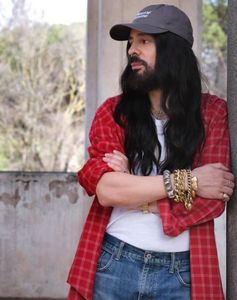It took five long years since the death of fashion genius Alexander McQueen for the world to fall in love again. By happy coincidence to a man with the same name. Alessandro Michele was named creative director of Gucci just a month shy of McQueen’s fifth death anniversary. By the time his first fashion show headlining for Gucci had rolled out, we were all shik-shak-shok.
Michele made our heads spin. His debut was a menswear show, a much harder market to break into. But his vintage-inspired, gender-fluid florals for men were groundbreaking. It heralded a new language in fashion, one that’s still an ongoing conversation. This was 2015, also the year when the US Supreme Court had announced that homosexual marriages would be legal across the US. Michele was for the new man, the new woman, and a new world.
Gucci’s profits went up by 50 per cent in two years. Under Michele, Gucci began to clock in €10 billion each year. Along with CEO Marco Bizzarri, Michele reimagined Gucci’s branding, advertising (they famously had a campaign that featured no white models at all), and stores. In December 2022, when Gucci couldn’t recover from the sales slump that followed the pandemic, Michele was sent out in the cold. I’m sure I shed a few tears, just as I did when news of McQueen’s passing broke.
This was the second time Gucci found itself without a creative director. In 2004, Tom Ford and Domenico De Sole, famously known as the Tom-Dom team, brought Gucci back from bankruptcy. Gucci now has ‘safe’ Sabato De Sarno as its head, but its profits are refusing to return.
Last week, Michele was announced as Valentino’s creative head. Valentino is much smaller in size than Gucci is, but it takes Michele back to his Roman roots (Valentino Garavani, 91, was a famous gown-maker out of Rome who retired in 2007. His is the first store in the city’s Via Condotti just beneath the Spanish Steps.) Valentino’s revenue is humble at €1.4 billion in comparison, just before it was hit by a slowdown, too (the group has not yet announced last year’s results). He also returns to his good friend Jacopo Venturini, the chief merchandiser at Gucci who is now CEO at Valentino.
Michele and Valentino are strange bedfellows—he is a kitschy streetwear guru while the label is posh, old-world romance. But if Kering, Gucci’s owner, can allow a shake-up at Gucci, surely Valentino owner Mayhoola can do the same at Valentino. Michele is an expert at rediscovering lost motifs from the archives and giving them a fresh twist.
Michele and his friends at Gucci (he had worked there for 12 years before he was appointed creative head) also brought on a massive brand punch, even the entry-level products were given a touch of quirk to invite newer buyers. The same approach could be just the shot in the arm that would swing the profits in favour of Valentino. Gucci, under Michele, became an innovative, artistic, visionary brand. All these terms are alien in the Valentino dictionary thus far. Gucci also collaborated with Adidas and Disney, and it would be fun to see Valentino be young and relevant again.
Mayhoola, the Qatari investment group that also owns Balmain, has deep pockets. But bringing in a star designer like Michele is unusual, as it plans to exit soon. Kering invested in Valentino last year taking a 30 per cent stake with it. Michele will then be back in the Kering fold, this time taking a hopefully super successful Valentino with him.
Like McQueen, Michele is no ordinary creative talent. He is a significant moment in time, a cultural signpost. Unlike McQueen, he is lucky to have got a second chance.


